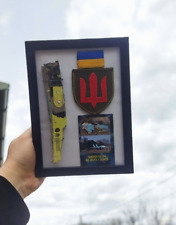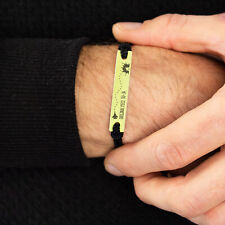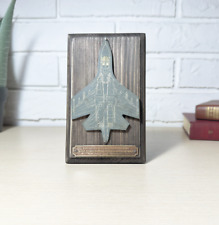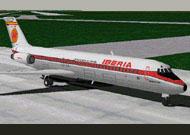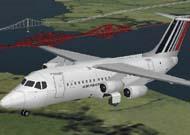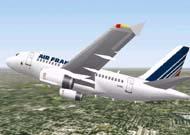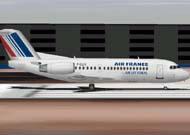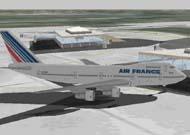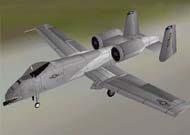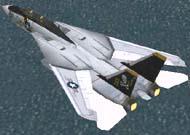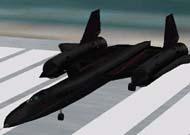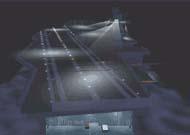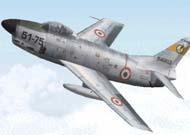When you click on links to various merchants on this site and make a purchase, this can result in this site earning a commission. Affiliate programs and affiliations include, but are not limited to, the eBay Partner Network.
Sukhoi Su-34 ModelSukhoi Su-34 Model A hand crafted Sukhoi Su-34 Model that was carefully carved from wood and hand-painted. Length – 18 inches The Sukhoi Su-34 (Russian: Сухой Су-34; NATO reporting name: Fullback) is a Soviet-origin Russian twin-engine, twin-seat, all-weather supersonic medium-range fighter-bomber/strike aircraft. It first flew in 1990, intended for the Soviet Air Forces, and it entered service in 2014 with the Russian Air Force. Based on the Sukhoi Su-27 Flanker air superiority fighter, the Su-34 has an armored cockpit for side-by-side seating of its two-man crew. The Su-34 is designed primarily for tactical deployment against ground and naval targets (tactical bombing/attack/interdiction roles, including against small and mobile targets) on solo and group missions in daytime and at night, under favourable and adverse weather conditions and in a hostile environment with counter-fire and electronic Warfare (EW) counter-measures deployed, as well as for aerial reconnaissance. The Su-34 will eventually replace the Su-24 tactical strike fighter and the Tu-22M3 long-distance bomber. Development The Su-34 had a muddied and protracted beginning. In the mid-1980s, Sukhoi began developing a new tactical multirole combat aircraft to replace the swing-wing Su-24, which would incorporate a host of conflicting requirements. The bureau thus selected the Su-27, which excelled in maneuverability and range, and could carry a large payload, as the basis for the new fighter-bomber.[18] More specifically, the aircraft was developed from T10KM-2, the naval trainer derivative of the Sukhoi Su-27K. The development, known internally as T-10V, was shelved at the end of the 1980s sharing the fate of the aircraft carrier Ulyanovsk; this was the result of the political upheaval in the Soviet Union and its subsequent disintegration. In August 1990, a photograph taken by a TASS officer showed an aircraft making a dummy approach towards the aircraft carrier Tbilisi. The aircraft, subsequently and erroneously labelled Su-27KU by Western intelligence, made its maiden flight on 13 April 1990 with Anatoliy Ivanov at the controls. Converted from an Su-27UB with the new distinctive nose, while retaining the main undercarriage of previous Su-27s, it was a prototype for the Su-27IB (Istrebitel Bombardirovshchik, or “fighter bomber”).It was developed in parallel with the two-seat naval trainer, the Su-27KUB. However, contrary to earlier reports, the two aircraft are not directly related. Flight tests continued throughout 1990 and into 1991. In 1992, the Su-27IB was displayed to the public at the MosAeroshow (later renamed “MAKS Airshow”), where it demonstrated aerial refuelling with an Il-78, and performed an aerobatic display. The aircraft was officially unveiled on 13 February 1992 at Machulishi, where Russian President Boris Yeltsin and the CIS leaders were holding a summit. The following year the Su-27IB was again displayed at the MAKS Airshow. The next prototype, and first pre-production aircraft, T10V-2, first flew on 18 December 1993, with Igor Votintsev and Yevgeniy Revoonov at the controls. Built at Novosibirsk, where Su-24s were constructed, this aircraft was visibly different from the original prototype; it had modified vertical stabilizers, twin tandem main undercarriage and a longer “stinger”, which houses an N012 rearward-facing warning radar, plus the drag chute and as well as fuel jettison outlet. The first aircraft built to production standard made its first flight on 28 December 1994. It was fitted with a fire-control system, at the heart of which was the Leninets OKB-designed V004 passive electronically scanned array radar. It was different enough from the earlier versions that it was re-designated the “Su-34”. However, at the 1995 Paris Air Show, the aircraft was allocated the “Su-32FN” designation, signalling the aircraft’s potential role as a shore-based naval aircraft for the Russian Naval Aviation. Sukhoi also promoted the Su-34 as the “Su-32MF” (MnogoFunksionalniy, “multi-function”). Budget restrictions caused the programme to stall repeatedly. Nevertheless, flight testing continued, albeit at a slow pace. The third pre-production aircraft first flew in late 1996. Russia’s Ministry of Defence plans to modernize the Su-34; according to the deputy head of the military department, Yuriy Borisov, “We are planning to modernize the aircraft: prolong its service life, increase the number of airborne weapons. Plane is in great demand in our armed forces, and it has a great future.” Russia is developing two new versions of the aircraft: one for electronic warfare (L700 Tarantul ECM pod can provide electronic cover for a group of aircraft) and one for Intelligence, surveillance, and reconnaissance. Su-34M modernised version will feature a new electro-optical infrared targeting pod, a Kopyo-DL rearward facing radar that can warn the pilots if missiles are approaching, combined with automatic deployment of countermeasures and jamming. Sukhoi Su-34 Model Sukhoi Su-34 Model
A hand crafted Sukhoi Su-34 Model that was carefully carved from wood and hand-painted.
Length – 18 inches
The Sukhoi Su-34 (Russian: Сухой Су-34; NATO reporting name: Fullback) is a Soviet-origin Russian twin-engine, twin-seat, all-weather supersonic medium-range fighter-bomber/strike aircraft. It first flew in 1990, intended for the Soviet Air Forces, and it entered service in 2014 with the Russian Air Force.
Based on the Sukhoi Su-27 Flanker air superiority fighter, the Su-34 has an armored cockpit for side-by-side seating of its two-man crew. The Su-34 is designed primarily for tactical deployment against ground and naval targets (tactical bombing/attack/interdiction roles, including against small and mobile targets) on solo and group missions in daytime and at night, under favourable and adverse weather conditions and in a hostile environment with counter-fire and electronic Warfare (EW) counter-measures deployed, as well as for aerial reconnaissance. The Su-34 will eventually replace the Su-24 tactical strike fighter and the Tu-22M3 long-distance bomber.
Development
The Su-34 had a muddied and protracted beginning. In the mid-1980s, Sukhoi began developing a new tactical multirole combat aircraft to replace the swing-wing Su-24, which would incorporate a host of conflicting requirements. The bureau thus selected the Su-27, which excelled in maneuverability and range, and could carry a large payload, as the basis for the new fighter-bomber.[18] More specifically, the aircraft was developed from T10KM-2, the naval trainer derivative of the Sukhoi Su-27K. The development, known internally as T-10V, was shelved at the end of the 1980s sharing the fate of the aircraft carrier Ulyanovsk; this was the result of the political upheaval in the Soviet Union and its subsequent disintegration.
In August 1990, a photograph taken by a TASS officer showed an aircraft making a dummy approach towards the aircraft carrier Tbilisi. The aircraft, subsequently and erroneously labelled Su-27KU by Western intelligence, made its maiden flight on 13 April 1990 with Anatoliy Ivanov at the controls. Converted from an Su-27UB with the new distinctive nose, while retaining the main undercarriage of previous Su-27s, it was a prototype for the Su-27IB (Istrebitel Bombardirovshchik, or “fighter bomber”).It was developed in parallel with the two-seat naval trainer, the Su-27KUB. However, contrary to earlier reports, the two aircraft are not directly related. Flight tests continued throughout 1990 and into 1991.
In 1992, the Su-27IB was displayed to the public at the MosAeroshow (later renamed “MAKS Airshow”), where it demonstrated aerial refuelling with an Il-78, and performed an aerobatic display. The aircraft was officially unveiled on 13 February 1992 at Machulishi, where Russian President Boris Yeltsin and the CIS leaders were holding a summit. The following year the Su-27IB was again displayed at the MAKS Airshow.
The next prototype, and first pre-production aircraft, T10V-2, first flew on 18 December 1993, with Igor Votintsev and Yevgeniy Revoonov at the controls. Built at Novosibirsk, where Su-24s were constructed, this aircraft was visibly different from the original prototype; it had modified vertical stabilizers, twin tandem main undercarriage and a longer “stinger”, which houses an N012 rearward-facing warning radar, plus the drag chute and as well as fuel jettison outlet. The first aircraft built to production standard made its first flight on 28 December 1994. It was fitted with a fire-control system, at the heart of which was the Leninets OKB-designed V004 passive electronically scanned array radar. It was different enough from the earlier versions that it was re-designated the “Su-34”. However, at the 1995 Paris Air Show, the aircraft was allocated the “Su-32FN” designation, signalling the aircraft’s potential role as a shore-based naval aircraft for the Russian Naval Aviation. Sukhoi also promoted the Su-34 as the “Su-32MF” (MnogoFunksionalniy, restrictions causéd the programme to stall repeatedly. Nevertheless, flight testing continued, albeit at a slow pace. The third pre-production aircraft first flew in late 1996.
Russia’s Ministry of Defence plans to modernize the Su-34; according to the deputy head of the military department, Yuriy Borisov, “We are planning to modernize the aircraft: prolong its service life, increase the number of airborne weapons. Plane is in great demand in our armed forces, and it has a great future.”
Russia is developing two new versions of the aircraft: one for electronic warfare (L700 Tarantul ECM pod can provide electronic cover for a group of aircraft) and one for Intelligence, surveillance, and reconnaissance.
Su-34M modernised version will feature a new electro-optical infrared targeting pod, a Kopyo-DL rearward facing radar that can warn the pilots if missiles are approaching, combined with automatic deployment of countermeasures and jamming.
× × × × × × × ×
Buy now and save! Shipping info
Click the Shipping & Payments tab above the listing description for more info
FREE Shipping
Click the Shipping & Payments tab above the listing description for more info!
Additional delivery notes
PICK UP OPTION
Sorry, our items are NOT available for pick-up.
PAYMENT
Immediate payment is required upon selecting \"Buy It Now\" or upon checking out through the cart.
We accept payment via U.S. PayPal accounts and all Major Credit Cards, Debit Cards & Google Pay.
We are legally required to collect sales tax in those states and localities where we maintain a physical presence (nexus).
The applicable amount of sales tax charged to an order will be calculated based on the shipment destination\'s state and local sales tax laws.
Thank you for shopping with us on !
Additional Information
No additional information at this time
Ask seller a question
You might also like VP-10 Red Lancers Plaque HT-28 Hellions Plaque Contact
To contact our Customer Service Team, simply click the button here and our Customer Service team will be happy to assist.
Ask seller a question
© Squadron Nostalgia LLC
Shipping & Payments
Shipping is FREE for this item
Payment
Accepted Payment Methods
Immediate payment is required upon selecting \"Buy It Now\" or upon checking out through the cart.
We accept payment via U.S. PayPal accounts and all Major Credit Cards, Debit Cards & Google Pay.
We are legally required to collect sales tax in those states and localities where we maintain a physical presence (nexus).
The applicable amount of sales tax charged to an order will be calculated based on the shipment destination\'s state and local sales tax laws.
Thank you for shopping with us on !
Returns
Returns are accepted
Items must be returned within 30 days of the sale ending
Seller will pay for return shipping.
integration by




